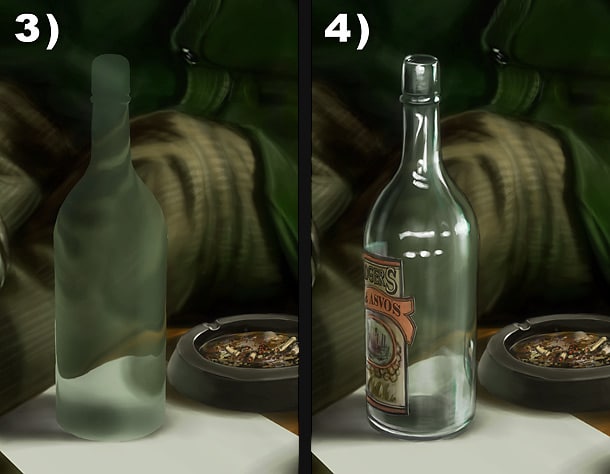How to paint glass
Glass is hard to paint. Be it simple windows to more complex shapes like statues, orbs, or objects like a glass or bottle. The reason why it is so complex is because of all the different attributes you have to consider. Breaking down the painting-process into separate “passes” is one way of approaching a clean workflow.
Silhouette and shape

Breaking up the rendering of glass into several passes simplifies the process. Start off with the basic silhouette shape, and choose the thickness of the glass by adjusting layer opacity.
1) First, create a solid silhouette shape and apply some rough shape to it. I chose green as some types of glass have a green quality.
2) Second, choose the transparency of the glass. You have different types of glass, and coloured, or translucent glass containing many air bubbles will be less transparent, naturally. The same goes for thickness; the thicker, the less transparent it becomes. Play with the layer opacity for this.
Refraction, reflections, and highlights

Creating refraction of what you see through the glass on a separate layer keeps your workflow clean. Try to think in 3D space where to place the highlights and reflections according to the surroundings.
3) Third, create refraction; the way the image seen though the glass gets distorted. This is also dependent on the complexity of the glass object. I simply copied the background into a new layer with the same shape as the bottle, and played around with the liquify filter. The more the surface of the glass is pointing away from you, the more it distorts.
4) The fourth and last point is the highlights and reflections which is what makes it looks like real glass. Now, imagine your glass object in 3D and how the angles of the object would reflect the highlights based on where the light sources are. The more light sources reflecting, the more it will looks like glass. High contrast objects lying close to the object will have to be hinted on as reflection.
Also; if you really want to go all out on this; you can experiment with how shadows and light gets influenced and broken by going through the object (as on a magnifying glass for example).

